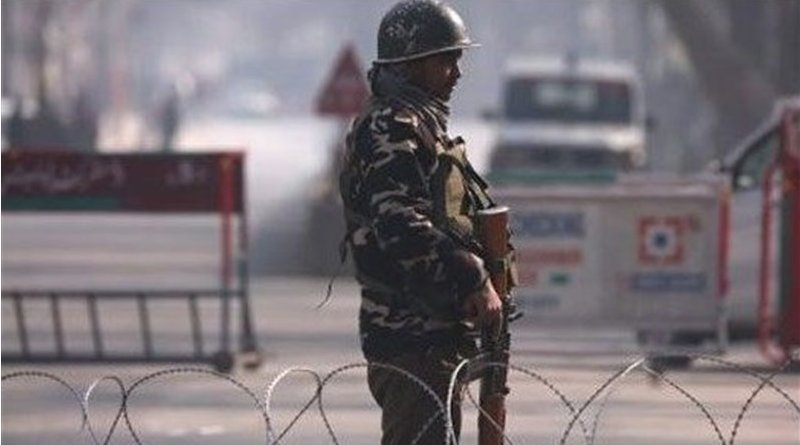COVID-19 And The Insurgency In Kashmir – Analysis
By IPCS
By Mohammed Sinan Siyech*
The COVID-19 pandemic has had a multi-dimensional impact across the world, including in conflict theatres. This commentary explores strategies that terror outfits might employ vis-à-vis the insurgency in Kashmir.
Infiltration Attempts
The most immediate threat is likely to pertain to the volume of infiltration attempts by terrorist groups into the Indian side of the Line of Control (LoC). According to Indian officials, several areas across Jammu and Kashmir (J&K) remain popular infiltration points for militants, especially those affiliated with Jaish-e-Mohammed (JeM) and Lashkar-e-Taiba (LeT). The 5 April 2020 shootout between Indian security forces and LeT operatives unearthed the group’s plots to target locations in India.
At present, troops in J&K have been mobilised to help maintain the COVID-19-induced lockdown, and provide medical aid and information to people living in remote corners of the Union Territory. Though essential, these services provided by the military could place a strain on government resources and efforts topolice borders, thereby increasing the risk of infiltrators exploiting the situation.
Security officials have been warning of militants and potential infiltrators mobilising along the LoC in Kashmir since February 2020. Furthermore, according to some reports, the newly formed group called ‘The Resistance Front’ claimed responsibility for various attacks leading to the deaths of Indian army personnel in April 2020. This also follows the general pattern in the Kashmir conflict wherein border skirmishes and terrorist activities often witness an uptick during summer months. Deploying the army for pandemic-related activities at such a juncture adds to the strain on the security scenario.
Image-Building Activities
Another tactic that terror outfits might employ to increase their presence in Kashmir is by propagating a narrative of assistance in fighting the pandemic and serving affected populations. Such activities could paint them in a positive light as aid providers, thereby potentially increasing their credibility among target populations. Pandemic responses by groups like the Taliban in Afghanistan, and al Qaeda affiliate, Hayat Tahrir al-Sham, in Syria, have included implementing social distancing measures and cancelling Friday prayers.
The possibility of the JeM and LeT implementing similar measures is not inconceivable. In the wake of natural disasters in 2005, 2010, and 2015 in Pakistan, LeT’s parent organisation, the Jamaat-ud-Dawa (JuD), positioned itself as a major aid organisation to various affected Pakistanis. Although they did not fundraise as much as legitimate aid agencies, they marketed themselves quite well during this time.
If these past trends are any indication, LeT and JeM could try to increase recruitment by providing medical aid to affected Pakistanis. In addition to medical aid, the group could exploit secondary issues arising from the pandemic, such as hunger and job losses. Recently, Pakistan’s Prime Minister, Imran Khan, announced that the country could fight only one of the two issues, i.e. the pandemic or poverty, due to a lack of sufficient state services. In this backdrop, it is not inconceivable that these militant groups might try and derive benefits from the pandemic (such as by increasing recruitment), which might then be directed towards India.
Propaganda
Another strategy the terrorist groups might employ would be linking their propaganda activities with pre-existing grievances in Kashmir. Groups like LeT and JeM might attempt to enlist Kashmiris from India as well, by capitalising on their grievances. However, this may be the weakest aspect of terrorist strategy at this time because in addition to the lockdown, internet restrictions are still in place in Kashmir, with only 2G speeds available. Security analysts must keep an eye out for propaganda in local languages.
Even if terror outfits with considerable infrastructure and capacity manage to launch a major media campaign, groups like al Qaeda and the Islamic State (IS) will still struggle to gain traction. This is because they lackground presence in Kashmir due to the localised nature of the conflict. Further, various stakeholders in the region oppose the two groups for fear of diluting the goals of their own respective agendas. For example, although al Qaeda affiliate Ansar Ghazwat-ul-Hind and the Islamic State Jammu and Kashmir have garnered support online, their ground presence is shaky and limited to proxies that are often successfully countered by the security forces.
Looking Ahead
Researchers have highlighted the pandemic’s potential to widen pre-existing schisms. In the context of the insurgency in Kashmir, terror outfits might still fall back on older tactics such as infiltrations, aid work, and propaganda to shore up support and target India. However, various factors will have a bearing on the potency of such attempts.
*Mohammed Sinan Siyech is a Senior Analyst with the International Centre for Political Violence and Terrorism Research, a constituent unit of the S Rajaratnam School of International Studies, Nanyang Technological University, Singapore.

